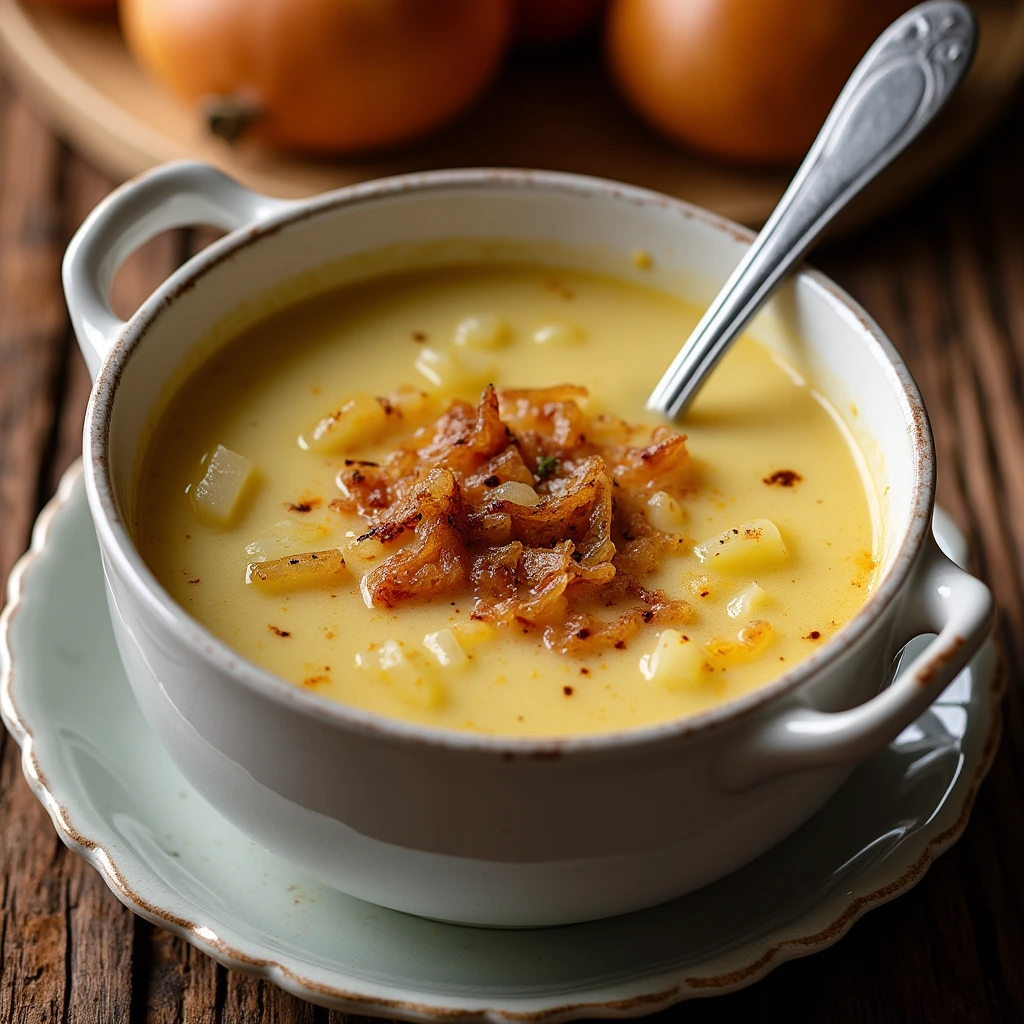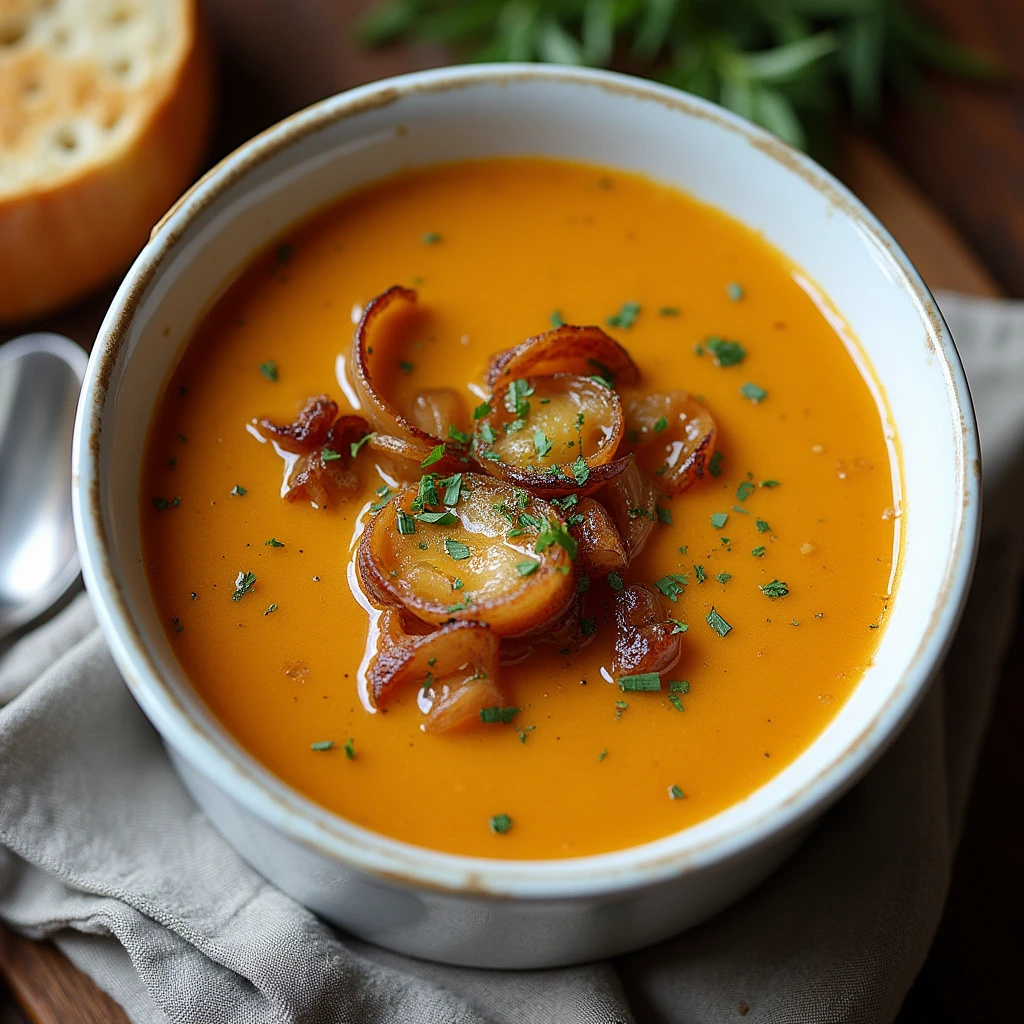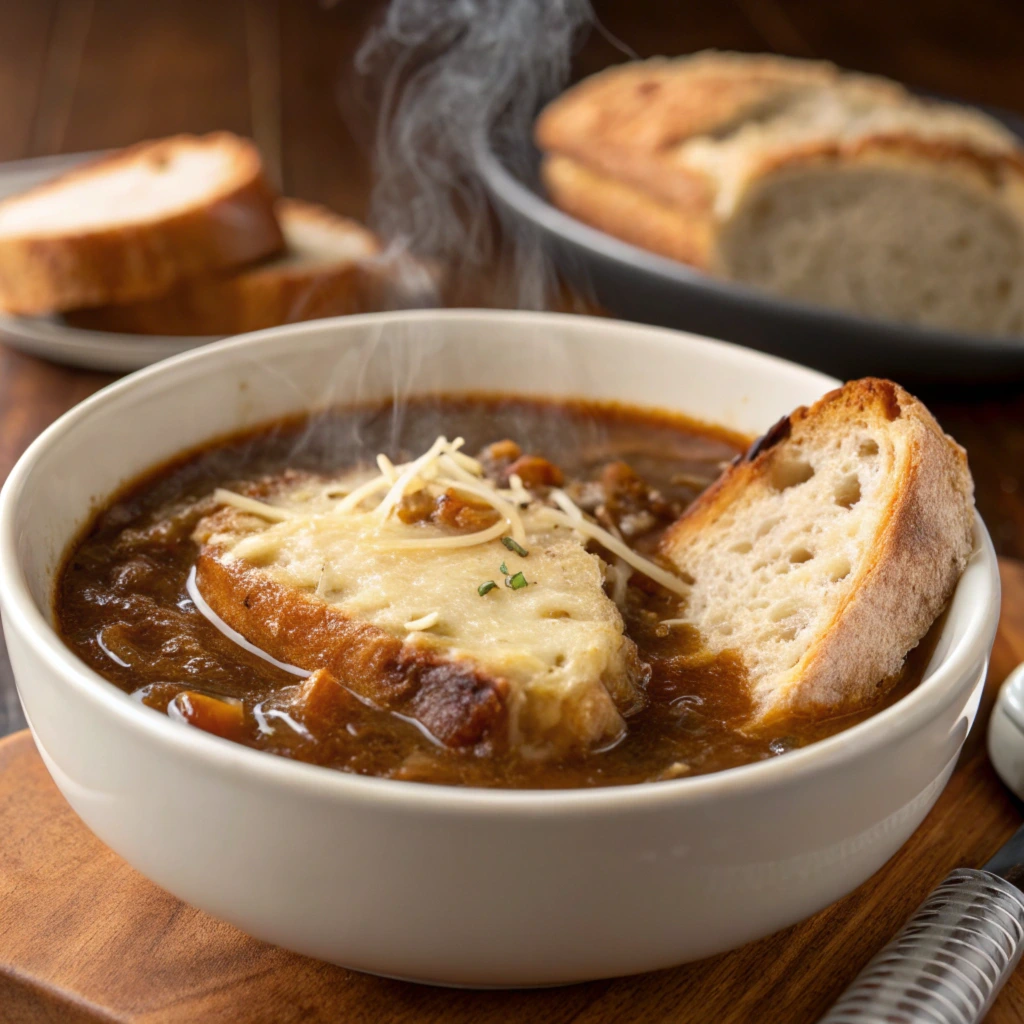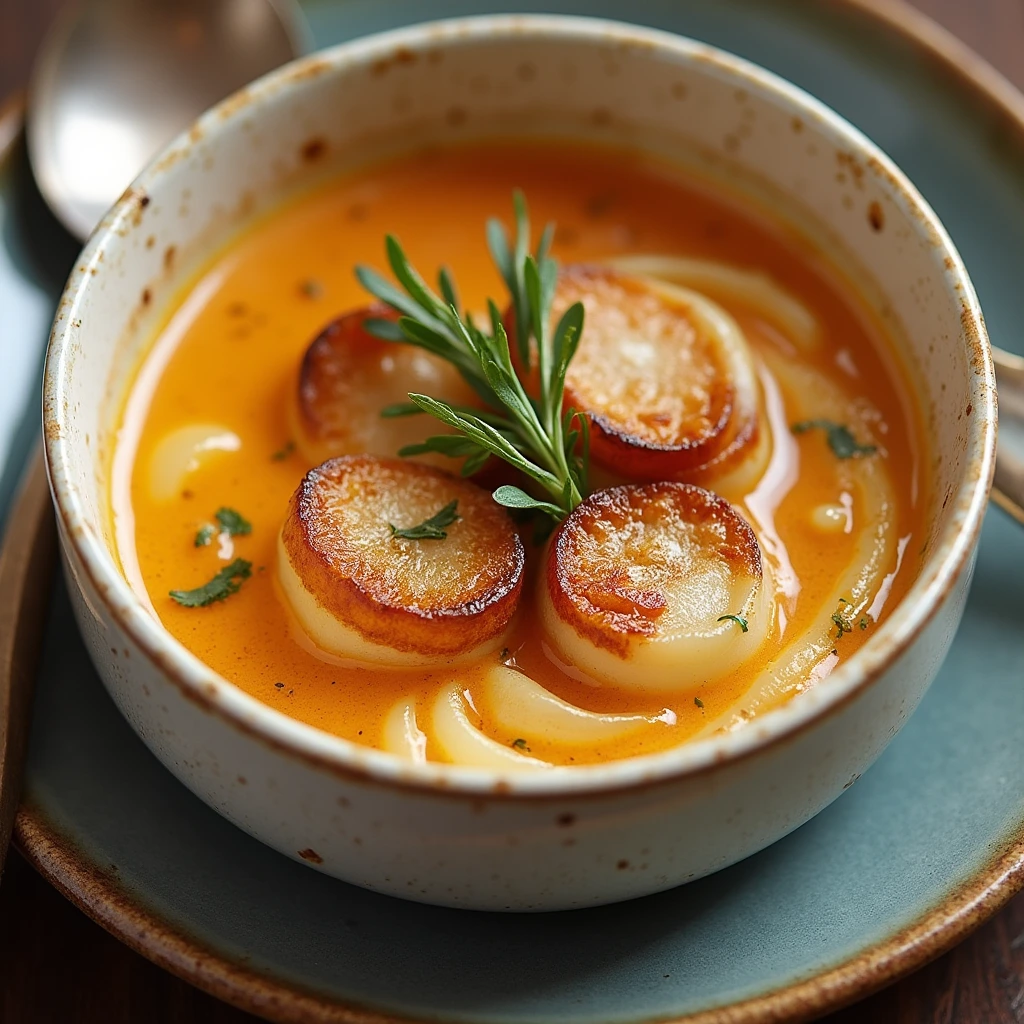Introduction
There’s something magical about a steaming bowl of French onion soup. The rich, savory broth, the sweet caramelized onions, and the gooey, golden cheese topping make it the ultimate comfort food. Whether you’re reminiscing about a cozy bistro in Paris or craving a hearty meal on a chilly evening, this classic dish never fails to warm the soul. In this guide, you’ll learn how to make authentic French onion soup at home, step by step. From selecting the right ingredients to mastering the art of caramelizing onions, we’ve got you covered. Let’s dive in!

What is French Onion Soup?
A Brief History of French Onion Soup
French onion soup, or soupe à l’oignon, has a rich history that dates back to Roman times. However, it gained widespread popularity in 18th-century France, where it was a staple among the working class. The dish was often enjoyed in the early hours of the morning by market workers and laborers who needed a hearty meal to start their day. Over time, it evolved into a beloved comfort food, celebrated for its simplicity and depth of flavor. Today, it’s a classic dish served in bistros and homes around the world, symbolizing warmth, comfort, and culinary tradition.
Why It’s a Classic Comfort Food
French onion soup is the epitome of comfort food. Its rich, savory broth, sweet caramelized onions, and cheesy bread topping create a harmonious blend of flavors and textures that warm you from the inside out. Whether you’re seeking solace on a cold winter night or simply craving a bowl of something hearty and satisfying, this soup delivers every time.
Key Characteristics of French Onion Soup
What sets French onion soup apart from other soups are its key characteristics:
- Caramelized onions: The foundation of the soup, providing a deep, sweet flavor.
- Rich broth: Typically made with beef broth, which adds depth and umami.
- Cheesy bread topping: A slice of crusty baguette covered in melted Gruyère cheese, creating a gooey, golden crust.
Popularity in Restaurants and Home Kitchens
French onion soup is a favorite on restaurant menus, particularly in French bistros. Its combination of simple ingredients and complex flavors makes it a crowd-pleaser. At home, it’s a versatile dish that can be customized to suit your taste, whether you prefer a traditional recipe or a modern twist.
Essential Ingredients for Authentic French Onion Soup
Onions
The star of the show, onions are the foundation of French onion soup. Yellow or sweet onions are the best choices because they caramelize beautifully, developing a deep, sweet flavor. You’ll need about 4-6 medium-sized onions, thinly sliced.
Broth
The broth is the backbone of the soup, providing depth and richness. Traditional French onion soup is made with beef broth, which adds a robust, savory flavor. For a vegetarian version, you can use vegetable broth.
Cheese
Cheese is what takes French onion soup to the next level. Gruyère is the classic choice because of its nutty flavor and excellent melting properties. If Gruyère is unavailable, Swiss or provolone are good substitutes.
Bread
A crusty baguette is essential for the topping. It’s sliced and toasted before being placed on top of the soup and covered with cheese. The bread soaks up the broth, adding a delightful texture to each bite.
Step-by-Step Guide to Making French Onion Soup
Step 1 – Caramelizing the Onions
Caramelizing onions is the most time-consuming part of making French onion soup, but it’s also the most important. Here’s how to do it:
- Slice onions thinly: Uniform slices ensure even cooking.
- Cook slowly: Melt butter or heat olive oil in a large pot over medium-low heat. Add the onions and cook slowly, stirring occasionally.
- Add a pinch of sugar: This helps enhance the caramelization process.
- Be patient: It takes about 30-45 minutes for the onions to turn a deep golden brown. Don’t rush this step—it’s what gives the soup its signature flavor.
Step 2 – Building the Broth
Once the onions are caramelized, it’s time to build the broth:
- Deglaze the pot: Add ½ cup of white wine (optional) to the pot and scrape up any browned bits from the bottom.
- Add broth: Pour in 6 cups of beef or vegetable broth.
- Simmer: Add a few sprigs of thyme, a couple of bay leaves, and minced garlic. Let the soup simmer for 20-30 minutes to allow the flavors to meld.
Step 3 – Preparing the Bread and Cheese Topping
While the soup simmers, prepare the bread and cheese topping:
- Toast baguette slices: Slice a crusty baguette and toast the slices in the oven at 350°F (175°C) for about 10 minutes, or until crispy.
- Grate cheese: Use about 1 ½ cups of Gruyère or Swiss cheese.
Step 4 – Assembling and Broiling
The final step is assembling and broiling the soup:
- Ladle soup into bowls: Use oven-safe bowls for this step.
- Add bread and cheese: Place a toasted baguette slice on top of each bowl of soup and cover it with a generous amount of grated cheese.
- Broil: Place the bowls under the broiler for 2-3 minutes, or until the cheese is bubbly and golden.

Tips for Perfect French Onion Soup Every Time
For more expert tips on perfecting your French onion soup, check out this comprehensive guide from Serious Eats, which dives deeper into techniques for caramelizing onions and achieving the best flavor.
Use a Mix of Onions
While yellow onions are the traditional choice, you can add depth of flavor by using a mix of yellow and red onions.
Cook Onions Low and Slow
Caramelizing onions is a slow process, but it’s worth the wait. Cooking them over low heat allows the natural sugars to develop, resulting in a deep, sweet flavor.
Choose the Right Cheese
Gruyère is the classic choice for French onion soup because of its nutty flavor and excellent melting properties. If you can’t find Gruyère, Swiss or provolone are good alternatives.
Adjust Seasoning
Taste the soup before serving and adjust the seasoning as needed. You may want to add a splash of Worcestershire sauce for extra umami or a pinch of salt and pepper to enhance the flavors.
Make It Ahead
French onion soup tastes even better the next day, as the flavors have more time to meld. You can prepare the soup in advance and reheat it when you’re ready to serve.

Serving and Pairing Suggestions
How to Serve French Onion Soup
French onion soup is traditionally served in individual oven-safe bowls, topped with a slice of toasted baguette and melted cheese. It’s a hearty dish that can be enjoyed as a starter or a main course.
Side Dishes
French onion soup is a versatile dish that can be paired with a variety of sides:
- Green salad: A fresh, crisp salad balances the richness of the soup.
- Charcuterie board: Add a touch of elegance to your meal with a selection of cured meats, cheeses, and olives.
Storing and Reheating
If you have leftovers, store the soup in an airtight container in the refrigerator for up to 3 days. To reheat, simply warm it on the stovetop over low heat. If you want to freeze the soup, do so without the bread and cheese topping.
Frequently Asked Questions About French Onion Soup
Can I Make French Onion Soup Vegetarian?
Yes, you can make a vegetarian version of French onion soup by using vegetable broth instead of beef broth. You can also skip the Worcestershire sauce or use a vegan alternative.
What’s the Best Cheese for French Onion Soup?
Gruyère is the traditional choice because of its nutty flavor and excellent melting properties. If Gruyère is unavailable, Swiss or provolone are good substitutes.
How Do I Prevent the Soup from Being Too Salty?
To avoid overly salty soup, use low-sodium broth and adjust the seasoning at the end. You can also taste the broth as it simmers and add water if necessary.
Can I Freeze French Onion Soup?
Yes, you can freeze French onion soup, but it’s best to do so without the bread and cheese topping. Store the soup in an airtight container and freeze for up to 3 months.
Variations of French Onion Soup
While the classic French onion soup recipe is timeless, there are plenty of ways to put your own spin on this beloved dish. Here are some creative variations to try:
Mushroom French Onion Soup
Add a savory twist by incorporating mushrooms into your soup. Sauté sliced mushrooms (such as cremini or shiitake) with the onions for an earthy, umami-rich flavor.
Vegetarian French Onion Soup
For a vegetarian version, swap the beef broth for vegetable broth and skip the Worcestershire sauce or use a vegan alternative. You can also add a splash of balsamic vinegar for depth.
Gluten-Free French Onion Soup
To make this soup gluten-free, use gluten-free bread for the topping and ensure your broth is gluten-free.
Spicy French Onion Soup
Add a kick of heat by incorporating a pinch of red pepper flakes or a dash of hot sauce into the broth.
French Onion Soup with a Twist
Experiment with different cheeses, such as smoked Gouda or blue cheese, for a unique flavor profile. You can also add a splash of brandy or sherry for a boozy twist.
Why French Onion Soup is a Crowd-Pleaser
French onion soup is a dish that appeals to almost everyone, making it a perfect choice for gatherings and special occasions. Here’s why it’s such a crowd-pleaser:
Comforting and Familiar
The warm, savory flavors of French onion soup evoke a sense of comfort and nostalgia, making it a hit with both adults and children.
Easy to Customize
Whether you’re catering to dietary restrictions or personal preferences, French onion soup is highly customizable. You can adjust the ingredients to suit your needs without compromising on flavor.
Impressive Yet Simple
Despite its gourmet reputation, French onion soup is surprisingly easy to make. With a few simple ingredients and some patience, you can create a dish that looks and tastes like it came from a fancy restaurant.
Perfect for Any Occasion
From casual weeknight dinners to elegant holiday meals, French onion soup fits seamlessly into any menu. Its versatility and universal appeal make it a go-to recipe for hosts and home cooks alike.

The Science Behind Caramelizing Onions
Caramelizing onions is a key step in making French onion soup, but have you ever wondered what’s actually happening during this process? Let’s break it down:
The Maillard Reaction
When onions are cooked slowly over low heat, the natural sugars in the onions undergo the Maillard reaction, a chemical process that creates complex, savory flavors and a rich brown color.
The Role of Heat and Time
Caramelizing onions requires patience. Cooking them over low heat for an extended period allows the sugars to break down gradually, resulting in a deep, sweet flavor.
Tips for Perfect Caramelization
- Use a heavy-bottomed pot to distribute heat evenly.
- Stir the onions occasionally to prevent burning.
- Add a pinch of sugar to speed up the caramelization process.
The History of Cheese in French Cuisine
Cheese plays a starring role in French onion soup, but its use in French cuisine goes far beyond this iconic dish. Here’s a brief look at the history of cheese in France:
A Rich Tradition
France is home to over 1,000 varieties of cheese, each with its own unique flavor and texture. Cheese has been a staple of French cuisine for centuries, dating back to the Roman era.
Regional Varieties
Different regions of France are known for their signature cheeses. For example, Gruyère comes from the Alpine region, while Camembert is a specialty of Normandy.
Cheese in French Culture
In France, cheese is more than just a food—it’s a way of life. It’s often enjoyed as part of a cheese course at the end of a meal, paired with wine and bread.
How to Choose the Best Ingredients
The quality of your ingredients can make or break your French onion soup. Here’s how to choose the best ingredients for the best results:
Onions
Look for firm, unblemished onions with dry, papery skins. Yellow or sweet onions are the best choices for caramelization.
Broth
If you’re using store-bought broth, opt for a high-quality, low-sodium variety. For an extra-rich flavor, consider making your own broth at home.
Cheese
Choose a cheese that melts well and has a rich, nutty flavor. Gruyère is the classic choice, but Swiss or provolone are good alternatives.
Bread
A crusty baguette is ideal for the topping. Look for a fresh loaf with a crisp crust and a soft interior.
French Onion Soup Around the World
While French onion soup is a classic French dish, it has been embraced by cultures around the world. Here’s how it’s enjoyed in different countries:
United States
In the U.S., French onion soup is a popular menu item at steakhouses and casual dining restaurants. It’s often served as a starter or a light meal.
United Kingdom
In the UK, French onion soup is a favorite at pubs and cafes. It’s sometimes served with a slice of toasted cheddar cheese on top.
Japan
In Japan, French onion soup has been adapted to suit local tastes. It’s often served with a lighter broth and a sprinkle of green onions.
Australia
In Australia, French onion soup is a popular comfort food, especially during the colder months. It’s often served with a side of crusty bread.
The Health Benefits of French Onion Soup
French onion soup isn’t just delicious—it’s also packed with nutrients. Here’s a look at some of the health benefits:
Onions
Onions are rich in antioxidants, vitamins, and minerals. They’ve been shown to support heart health, boost immunity, and reduce inflammation.
Broth
Broth is a good source of hydration and provides essential nutrients like collagen, which supports joint and skin health.
Cheese
Cheese is a good source of calcium and protein, which are important for bone health and muscle repair.
Bread
Whole-grain bread provides fiber, which supports digestion and helps keep you feeling full.
French Onion Soup in Popular Culture
French onion soup has made its mark in popular culture, appearing in movies, TV shows, and literature. Here are a few notable mentions:
Movies and TV Shows
French onion soup has been featured in films like Julie & Julia and TV shows like Friends, where it’s often portrayed as a symbol of comfort and sophistication.
Literature
In literature, French onion soup is often used to evoke a sense of nostalgia and warmth. It’s mentioned in books like The Little Paris Kitchen by Rachel Khoo.
Social Media
On platforms like Instagram and TikTok, French onion soup has become a popular subject for food bloggers and home cooks. Its cheesy, golden topping is especially photogenic.
Conclusion
French onion soup is more than just a dish—it’s an experience. From the slow caramelization of onions to the final broiling of cheese, every step of the process is a labor of love. Whether you’re a seasoned cook or a beginner, this recipe is a must-try. It’s comforting, flavorful, and perfect for any occasion. So, gather your ingredients, roll up your sleeves, and get ready to create a masterpiece in your kitchen. Bon appétit!
Call-to-Action: Have you tried making French onion soup at home? Share your experience, tips, or favorite variations in the comments below!
